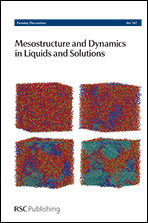Liquid organization and solvation properties at polar solid/liquid interfaces
Abstract
Second order nonlinear optical spectroscopy has been employed to examine the organization of four different liquids at the hydrophilic silica/liquid interface. The liquids – cyclohexane, methylcyclohexane, 1-propanol, and 2-propanol – were chosen to isolate how intermolecular forces between the liquid and the substrate competed with steric effects to control liquid structure and solvating properties across the interfacial region. Vibrational sum frequency generation (VSFG) data showed that cyclohexane structure at the silica/liquid cyclohexane interface closely resembled the structure of a cyclohexane monolayer adsorbed to the silica/vapor interface. Methylcyclohexane, however, showed evidence of large structural reorganization between the silica/liquid and silica/monolayer/vapor interfaces. 1-Propanol at a silica/vapor interface formed a well-ordered, Langmuir-like monolayer due to strong hydrogen bonding with the surface silanols and cohesive van der Waals interactions between carbon chains. 1-Propanol at the silica/liquid interface retained the same ordered structure. In contrast, 2-propanol adopted different structures adsorbed to the solid/vapor and at the solid/liquid interfaces. Specifically, the plane defined by 2-propanol's three carbon atoms changed orientation from being perpendicular to the surface (silica/vapor) to parallel to the surface (silica/liquid). Surface mediated liquid structure affected the solvation of adsorbed solutes. Resonance enhanced second harmonic generation (SHG) data showed that silica/alkane interfaces were significantly more polar than would be expected based on a solute's bulk solution solvatochromic behavior. Both silica/alcohol interfaces exhibited alkane-like polarity, a result that was interpreted in terms of a reduction in hydrogen bonding opportunities for adsorbed solutes.
- This article is part of the themed collection: Mesostructure and Dynamics in Liquids and Solutions

 Please wait while we load your content...
Please wait while we load your content...